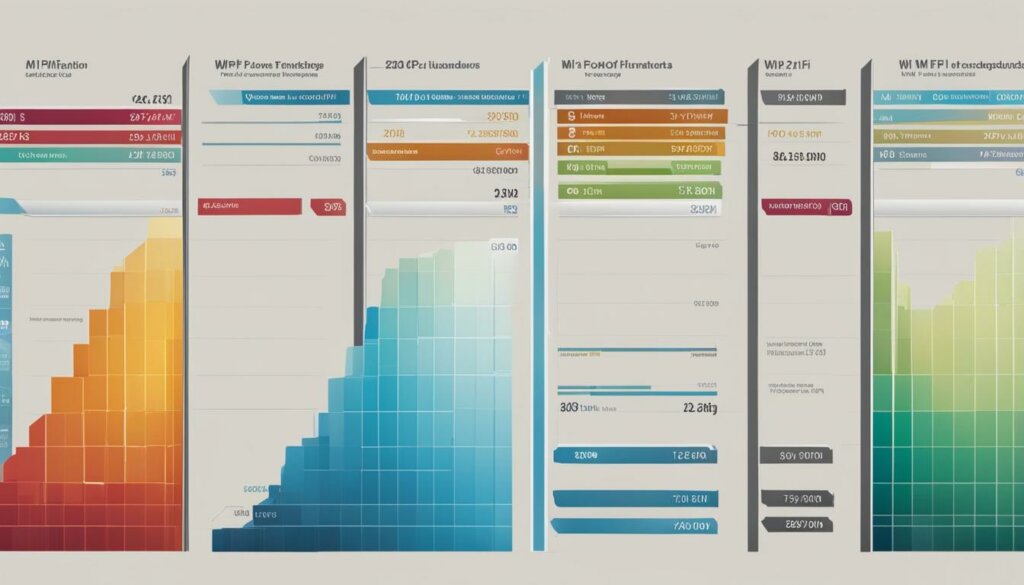Table of Contents
Welcome to our comprehensive guide on the latest Wi-Fi standards and their benefits. In this article, we will explore the evolution of Wi-Fi technology, understand the differences between Wi-Fi 6 and Wi-Fi 5, and introduce other important Wi-Fi standards. Whether you’re setting up a new network or upgrading your existing one, understanding these standards is vital for optimizing your Wi-Fi experience.
The Evolution of Wi-Fi Technology
Wi-Fi technology is based on the IEEE 802.11 standard, which has undergone several updates and revisions over the years. The earlier standards, such as 802.11a, 802.11b, and 802.11g, provided basic wireless connectivity with limited speed and range. The introduction of 802.11n brought significant improvements in speed and coverage, followed by the widely adopted 802.11ac standard. The latest standard, Wi-Fi 6 (802.11ax), offers even faster speeds, increased capacity, and improved efficiency.
“Wi-Fi technology has come a long way since its inception, constantly evolving to meet the growing demands of wireless connectivity.”
With each new generation, Wi-Fi standards have delivered improved performance and enhanced user experiences. The table below highlights the key features and capabilities of different Wi-Fi standards:
| Wi-Fi Standard | Release Year | Frequency Band | Maximum Data Rate | Modulation |
|---|---|---|---|---|
| 802.11a | 1999 | 5 GHz | 54 Mbps | OFDM |
| 802.11b | 1999 | 2.4 GHz | 11 Mbps | DSSS |
| 802.11g | 2003 | 2.4 GHz | 54 Mbps | OFDM |
| 802.11n | 2009 | 2.4 GHz / 5 GHz | Wi-Fi 4 / Wi-Fi 5 | OFDM / OFDMA |
| 802.11ac | 2013 | 5 GHz | Wi-Fi 5 | OFDM / OFDMA |
| Wi-Fi 6 (802.11ax) | 2019 | 2.4 GHz / 5 GHz | Wi-Fi 6 | OFDMA |
Table: Key Features and Capabilities of Wi-Fi Standards
As technology continues to advance, Wi-Fi standards will continue to evolve, providing faster speeds, increased capacity, and improved efficiency. Understanding the different Wi-Fi standards and their capabilities is essential for making informed decisions when setting up or upgrading your Wi-Fi network.
Understanding Wi-Fi 6 (802.11ax)
Wi-Fi 6, also known as 802.11ax, is the latest Wi-Fi standard that offers significant improvements in wireless connectivity. With the increasing demand for high-speed internet and the growing number of devices connected to a network, Wi-Fi 6 provides a solution for enhanced speed, capacity, and efficiency.
One of the key advantages of Wi-Fi 6 is its faster speeds, allowing for quicker downloads, seamless streaming, and improved overall performance. This is made possible through advanced technologies such as Orthogonal Frequency Division Multiple Access (OFDMA), which enables more efficient data transmission by dividing wireless channels into smaller sub-channels.
Wi-Fi 6 also offers increased capacity to handle more devices simultaneously, which is crucial in today’s connected world. It utilizes multi-user MIMO (Multiple Input Multiple Output) technology to transmit data to multiple devices at the same time, reducing latency and improving network efficiency. This means that even in crowded environments with multiple devices connected, Wi-Fi 6 can deliver a smooth and uninterrupted user experience.
In addition to speed and capacity improvements, Wi-Fi 6 also focuses on efficiency. It implements Target Wake Time (TWT) technology, allowing devices to schedule when they wake up to transmit and receive data. This helps conserve battery life, especially in devices like smartphones and IoT devices, which can significantly benefit from this power-saving feature.
The Benefits of Wi-Fi 6 (802.11ax):
- Significantly faster speeds for quick downloads and seamless streaming
- Increased capacity to handle more devices simultaneously
- Improved efficiency and battery life conservation
- Enhanced performance in congested environments
- Optimal user experience for a wide range of applications and devices
In summary, Wi-Fi 6 (802.11ax) is the latest Wi-Fi standard that brings faster speeds, increased capacity, improved efficiency, and better performance in crowded environments. It is designed to meet the demands of today’s high-bandwidth applications and the growing number of connected devices. Upgrading to Wi-Fi 6 can provide a significant boost to your wireless network, ensuring a seamless and enhanced user experience.
Exploring Wi-Fi 5 (802.11ac)
Wi-Fi 5, also known as 802.11ac, is a widely adopted Wi-Fi standard that provides enhanced wireless connectivity. With its faster speeds, increased capacity, and improved performance, Wi-Fi 5 delivers a significant upgrade compared to older Wi-Fi standards.
One of the key advantages of Wi-Fi 5 is its ability to provide faster data transfer speeds. It operates in the 5 GHz frequency band, which offers better bandwidth and reduced interference compared to the crowded 2.4 GHz band. This allows for smoother streaming, quicker downloads, and overall faster internet experiences.
In addition to speed, Wi-Fi 5 also offers increased capacity to handle multiple devices simultaneously. It utilizes advanced technologies like multi-user MIMO (Multiple Input Multiple Output) to support multiple spatial streams, enabling more efficient data transmission and better network performance.
Wi-Fi 5 offers faster speeds, increased capacity to handle multiple devices, and improved performance compared to older standards.
| Wi-Fi Standard | Frequency Band | Maximum Data Rate | Modulation |
|---|---|---|---|
| Wi-Fi 5 (802.11ac) | 5 GHz | Up to 1.3 Gbps | 256-QAM |
| Wi-Fi 4 (802.11n) | 2.4 GHz/5 GHz | Up to 600 Mbps | 64-QAM |
| Wi-Fi 3 (802.11g) | 2.4 GHz | Up to 54 Mbps | 64-QAM |
Overall, Wi-Fi 5 (802.11ac) is still widely used in many devices and offers significant benefits for both home and business networks. Its faster speeds, increased capacity, and improved performance make it a reliable choice for those looking to upgrade their Wi-Fi connectivity.
The Key Differences between Wi-Fi 6 and Wi-Fi 5
When it comes to wireless standards, Wi-Fi 6 (802.11ax) and Wi-Fi 5 (802.11ac) are two of the most significant ones. Understanding the key differences between these standards is crucial for optimizing your Wi-Fi network and ensuring optimal performance. Let’s take a closer look at how Wi-Fi 6 and Wi-Fi 5 differ in terms of frequency bands, spatial streams, maximum data rates, modulation, and overall performance.
Frequency Bands:
One of the main differences between Wi-Fi 6 and Wi-Fi 5 lies in the frequency bands they operate in. Wi-Fi 6 operates in both the 2.4 GHz and 5 GHz bands, whereas Wi-Fi 5 primarily operates in the 5 GHz band. The inclusion of the 2.4 GHz band in Wi-Fi 6 allows for improved compatibility with older devices that may only support this frequency.
Spatial Streams:
Wi-Fi 6 supports more spatial streams compared to Wi-Fi 5. Spatial streams refer to the number of independent data streams that can be transmitted simultaneously. Wi-Fi 6 can support up to 12 spatial streams, while Wi-Fi 5 supports up to 8. This means that Wi-Fi 6 has the potential to deliver faster speeds and increased capacity, especially in environments with multiple devices.
Maximum Data Rates:
Wi-Fi 6 offers higher maximum data rates compared to Wi-Fi 5. The maximum data rate for Wi-Fi 6 can reach up to 9.6 Gbps, while Wi-Fi 5 has a maximum data rate of up to 3.5 Gbps. This increased data rate allows for faster downloads, smoother streaming, and improved overall performance.
Modulation:
Both Wi-Fi 6 and Wi-Fi 5 use different modulation techniques to transmit data. Wi-Fi 6 utilizes more advanced modulation, such as 1024-QAM, compared to Wi-Fi 5’s 256-QAM. This enables Wi-Fi 6 to deliver more data with each transmission, resulting in improved efficiency and faster speeds.
Overall, Wi-Fi 6 offers significant advancements over Wi-Fi 5 in terms of frequency bands, spatial streams, maximum data rates, and modulation techniques. These differences translate into improved performance, increased capacity, and better support for IoT devices. Understanding these distinctions can help you make informed decisions when setting up or upgrading your Wi-Fi network to ensure the best wireless experience for your users.
| Wi-Fi Standard | Frequency Bands | Spatial Streams | Maximum Data Rates | Modulation |
|---|---|---|---|---|
| Wi-Fi 6 (802.11ax) | 2.4 GHz and 5 GHz | Up to 12 | Up to 9.6 Gbps | 1024-QAM |
| Wi-Fi 5 (802.11ac) | Primarily 5 GHz | Up to 8 | Up to 3.5 Gbps | 256-QAM |
Introducing Other Wi-Fi Standards
In addition to Wi-Fi 6 and Wi-Fi 5, there are several other Wi-Fi standards that have played a significant role in the evolution of wireless connectivity. These standards have contributed to the advancements in speed, coverage, and performance that we enjoy today.
One of the earlier standards is 802.11n, which introduced improved speeds and coverage compared to its predecessors. It operates in both the 2.4 GHz and 5 GHz frequency bands and supports multiple antennas for better signal reception. Wi-Fi devices that are compatible with 802.11n can achieve faster data transfer rates and improved range.
Another standard that gained popularity is 802.11g. It operates in the 2.4 GHz band, offering compatibility with devices that only support this frequency. Although 802.11g provides slower speeds compared to 802.11n and later standards, it still offers significant benefits for basic wireless connectivity in home and small office environments.
Additionally, there are the legacy standards, namely 802.11b and 802.11a. 802.11b was one of the earliest Wi-Fi standards and operates in the 2.4 GHz band. It provides slower speeds and limited coverage compared to newer standards but can still be found in older devices. On the other hand, 802.11a operates exclusively in the 5 GHz band, providing faster speeds and less interference than 802.11b. However, since it operates in a higher frequency, its range is generally shorter.

Understanding these Wi-Fi standards can help you make informed decisions when setting up or upgrading your Wi-Fi network. By knowing the capabilities and limitations of each standard, you can choose the most suitable one for your specific needs. Whether you require faster speeds, wider coverage, or compatibility with older devices, the different Wi-Fi standards offer options to meet your requirements.
Overall, the evolution of Wi-Fi standards has paved the way for the seamless wireless connectivity we enjoy today. From the earlier standards like 802.11b and 802.11g to the more recent Wi-Fi 6 and Wi-Fi 5, each standard has contributed to the continuous improvement of wireless technology. By staying informed about these standards, you can ensure that your Wi-Fi network remains up to date and optimized for the best possible performance.
The Benefits of Upgrading to Wi-Fi 6
Upgrading to Wi-Fi 6 (802.11ax) brings a multitude of benefits for both home and business networks. This latest Wi-Fi standard offers faster speeds, increased capacity, improved efficiency, and enhanced user experiences.
One of the key advantages of Wi-Fi 6 is its faster speeds, which can deliver up to 40% higher peak data rates compared to Wi-Fi 5. This means faster downloads, smoother streaming, and quicker browsing experiences for users. Whether you’re streaming high-definition videos, playing online games, or transferring large files, Wi-Fi 6 ensures a seamless and lag-free connection.
Another significant benefit of Wi-Fi 6 is its increased capacity to handle multiple devices simultaneously. With the growing number of smart devices in our homes and offices, this upgrade is crucial. Wi-Fi 6 utilizes advanced technologies such as Orthogonal Frequency Division Multiple Access (OFDMA) and multi-user MIMO to efficiently manage and distribute network resources, allowing multiple devices to connect without experiencing a slowdown in performance.
Efficiency is also a key aspect of Wi-Fi 6. This standard incorporates Target Wake Time (TWT) technology, which allows devices to schedule their wake-up times and conserve battery life. This is particularly useful for IoT devices that rely on battery power. With Wi-Fi 6, these devices can operate for longer periods without the need for frequent battery replacements, reducing costs and inconvenience.
Upgrading to Wi-Fi 6 can significantly enhance the overall user experience, enabling smooth streaming, faster downloads, and seamless connectivity for all your devices.
| Benefits of Upgrading to Wi-Fi 6 |
|---|
| Faster speeds |
| Increased capacity to handle multiple devices |
| Improved efficiency to conserve battery life |
| Better performance in congested environments |
Maximizing the Potential of Wi-Fi Standards
To make the most of Wi-Fi standards, it is essential to optimize your network setup. By following best practices and understanding the capabilities of different Wi-Fi standards, you can ensure a reliable wireless connectivity experience for your devices. Here are some key factors to consider when maximizing the potential of Wi-Fi standards:
1. Choose the right hardware
Investing in high-quality routers and access points that support the latest Wi-Fi standards is crucial. Look for devices that are Wi-Fi 6 (802.11ax) or Wi-Fi 5 (802.11ac) compatible to take advantage of the faster speeds, increased capacity, and improved efficiency offered by these standards. Additionally, consider devices that support advanced features like OFDMA and MIMO technology for optimal performance.
2. Configure your router and devices correctly
Properly configuring your router and devices can significantly impact the performance of your Wi-Fi network. Ensure that your router is placed in a central location for maximum coverage and minimal interference. Set up secure passwords and enable encryption protocols like WPA3 to protect your network from unauthorized access. Additionally, update your devices’ firmware and drivers regularly to benefit from bug fixes and performance improvements.
3. Ensure proper signal coverage
Wi-Fi signals can be affected by various factors such as walls, distance, and interference from other electronic devices. To ensure optimal signal coverage, consider using Wi-Fi range extenders or mesh systems to expand coverage in larger spaces or areas with weak signals. Conduct a site survey to identify potential dead zones and adjust your network setup accordingly.
4. Keep firmware and software up to date
Manufacturers regularly release firmware updates to improve the performance and security of their networking devices. Stay updated with the latest firmware releases for your router and other devices. Similarly, ensure that your devices’ operating systems and Wi-Fi drivers are up to date to benefit from the latest optimizations and bug fixes.
By implementing these optimization strategies and staying informed about the latest Wi-Fi standards, you can maximize the potential of your Wi-Fi network and enjoy faster speeds, increased capacity, improved efficiency, and a seamless wireless experience for all your devices.
Conclusion
Wi-Fi standards have evolved significantly over the years, with each new generation bringing faster speeds, increased capacity, and improved efficiency. The latest standards, Wi-Fi 6 (802.11ax) and Wi-Fi 5 (802.11ac), offer significant benefits for wireless connectivity. Understanding these standards and their differences is crucial for optimizing your Wi-Fi network and ensuring an optimal user experience.
By keeping up to date with the latest Wi-Fi standards, such as Wi-Fi 6 and Wi-Fi 5, you can take full advantage of their capabilities. These standards provide faster speeds, increased capacity to handle multiple devices, improved efficiency to prolong battery life, and better performance in congested environments.
Whether you’re setting up a new Wi-Fi network or upgrading an existing one, it’s important to consider the benefits of Wi-Fi 6 and Wi-Fi 5. These standards, based on the IEEE 802.11 wireless protocols, offer advanced features that can significantly enhance your wireless connectivity.
Take advantage of the benefits offered by Wi-Fi 6 and Wi-Fi 5 by optimizing your network setup. This includes choosing the right hardware, configuring your router and devices correctly, ensuring proper signal coverage, and keeping your firmware and software up to date. By making informed decisions and understanding the capabilities of different Wi-Fi standards, you can create a high-performance Wi-Fi network that meets your needs.
FAQ
What are the benefits of Wi-Fi 6 (802.11ax) and Wi-Fi 5 (802.11ac)?
Wi-Fi 6 and Wi-Fi 5 offer faster speeds, increased capacity, improved efficiency, and better performance in congested environments.
What is the difference between Wi-Fi 6 and Wi-Fi 5?
Wi-Fi 6 operates in the 5 GHz band, supports more spatial streams, has higher maximum data rates, and offers better overall performance compared to Wi-Fi 5.
What are the other Wi-Fi standards?
There are other Wi-Fi standards such as 802.11n, 802.11g, 802.11b, and 802.11a that have played a significant role in wireless connectivity.
How does upgrading to Wi-Fi 6 benefit home and business networks?
Upgrading to Wi-Fi 6 provides faster speeds, increased capacity, improved efficiency, and better performance in congested environments, enhancing the overall user experience.
How can I optimize my Wi-Fi network setup?
To optimize your Wi-Fi network, ensure you choose the right hardware, configure your router and devices correctly, maintain proper signal coverage, and keep your firmware and software up to date.
Source Links
- https://www.wi-fi.org/discover-wi-fi/wi-fi-certified-6
- https://www.techtarget.com/searchnetworking/tip/Whats-the-difference-between-80211ax-vs-80211ac
- https://www.makeuseof.com/tag/understanding-common-wifi-standards-technology-explained/













